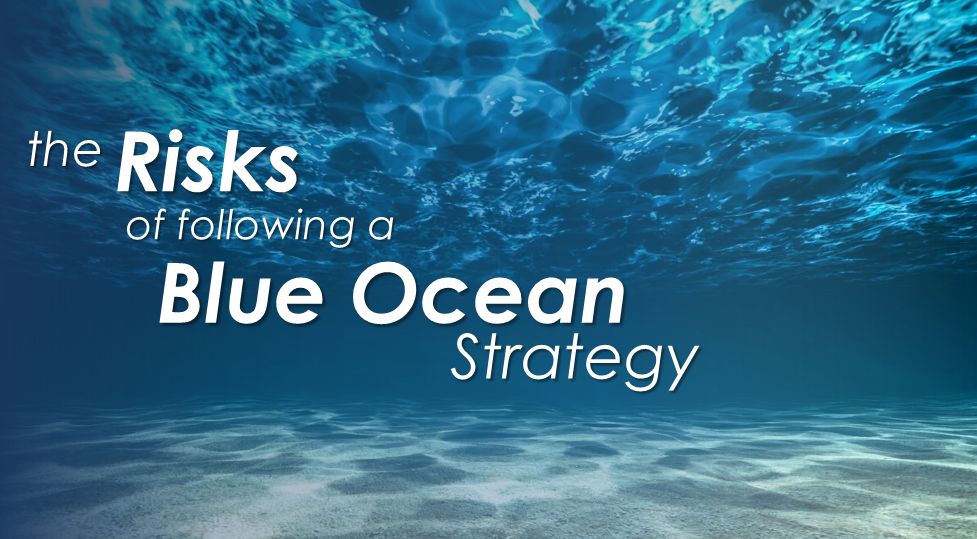Adopting a Blue Ocean Strategy, pivoting to a brand-new markets without competitors, is, for many, the holy grail of corporate strategy. Who does not want to make competitors irrelevant and to in grow a vast, blue, new market uncontested? It it smooth sailing or is it too good to be true?
Pursuing a Blue Ocean strategy can be a great choice for many companies, but it is not without risks or challenges. It’s also not easy. Otherwise, every company would pursue a blue ocean. Let’s start with the definition of blue ocean and then let’s explore the challenges and risks in pursuing such a strategy.
What is Blue Ocean Strategy?
Blue Ocean Strategy is a theory explained in a 2005 book by W. Chan Kim and Renée Mauborgne, professors at INSEAD. The fundamental premise is that most companies fight competitors head-to-head in the same space, chasing the same customers with very similar products, creating a bloody-red ocean in their feeding frenzy.
Instead, companies should pursue new spaces, “blue oceans”, untapped markets with no competitors, enjoying new levels of growth and improved profitability. Pursuing a blue ocean is in essence what I suggested in a post would have been a good strategy for Radio Shack: focusing on a smaller, but relatively uncontested market of DIY electronics.
A better example is Cirque du Soleil, as they shifted away from the traditional circus by creating a completely new category of entertainment that is more theatrical and artistic, resulting in a multi-billion dollar success.
There are great success stories that show the power of blue ocean strategies. It’s tempting to assume this is the right strategy for every company. It would be a mistake not to understand the risks, and to also study all the companies that failed in pursuit of new oceans.
The Risks of a Blue Ocean Strategy
1. Finding the right blue ocean. Blue ocean sounds great: go to a new market. Yes, but which one? it’s not that easy to come up with new ideas and identify large, untapped markets. There are thousands of stories of companies that could not find profitable new markets. By definition, these markets are new, uncontested, no one is there. Strategy is a choice. Choosing the right blue ocean strategy must be the result of a deliberate and detailed process, backed by the right research. There is no magic formula or silver bullet.
2. Arriving too early. First mover advantage is a myth. Kodak invented the first digital camera. The iPhone was a couple years late to the smartphone party. Entering a market too early is a clear risk. Customers might not understand what you are trying to sell. The technology might not be fully developed. The Amiga computer was a decade ahead of PCs and Macs, it was a technological marvel, and it died because the World was not ready for it. The Apple Newton and the first Microsoft Tablet PCs, were the right ideas, just a couple years too early.
3. Being too new, too different. Some blue oceans are free of predators, but also free of fish. Many companies come up with great ideas but the market is not ready. New markets introduce new terminology, solve new problems, or solve existing problems in new ways. Consumers don’t like too much change. When P&G introduced their improved concentrated laundry detergents, it failed because consumers could not conceive how a few drops could clean as well as a cap-full of Tide. We don’t like change. I am typing this post on a QWERTY keyboard layout, designed in the early mechanical typewriter era (1873) to slow typing down. The DVORAK keyboard, designed in 1936, is clearly superior for this age, yet we don’t want to change.
4. Strategy execution. Entering a new market is difficult. You need to be smart about who is your customer, what problem you are solving, how to educate them on new ideas, new products, new solutions – and how to explain the value of the new way of doing business. Tassimo had a better product than Keurig when both entered the new single-pod coffee market. Tassimo did not execute, and it is all but dead now. Keurig did a better job in executing the same idea, with an inferior product. Corporate mindset is a challenge too.
5. Strategic clarity and corporate mindset. It’s not enough to decide you want to go in a different direction, you need to shift the direction of your company. This requires clarity about the new destination, the trade-offs it requires, the challenges of getting there. Corporate culture, often has to shift. Everyone in the organization needs to understand the new set of customers, the new rules implicit in the new strategy. When Rackspace pivoted to the cloud, it had to evolve the thinking prevalent in every one of its thousands of employees from hosting servers to providing a platform. Failing to get employees on board with the new direction can prevent you from getting to the blue ocean.
6. Trust and patience. Going to a different ocean, a blue ocean, requires a lot of trust, preparation and faith. Results most likely won’t be immediate, so it requires patience. Investors, executives and employees should be realistic about the time required to be successful in a new market. Milestones that show meaningful progress are going to be important. It is also important to look at early indicators to confirm you are not fishing in a dead sea. Many companies when pivoting to a new strategy, don’t do it gradually, they bet the farm. And they are not always right.
6. Defensibility. The moment you find a new ocean, other sharks from your former red ocean and other adjacent oceans will be attracted to your new market. Cirque’s pristine blue ocean is being pursued by new competitors, like Wynn’s LaReve. New markets where profits can be found don’t remain the domain of a single player for long. You need to build defensibility into your strategy. Your strategy to defend your market (and profits) can consist of speed of execution, brand power, or technology – among others. It’s better to start building defenses as soon as you arrive in your new market.
Yes, it is possible to be successful pursuing a Blue Ocean strategy. Many companies have done it. The number of companies that failed in the attempt is probably larger, their skeletons lie now at the bottom of the sea.

